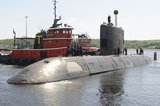USS Detroit begins testing of SSMM
The US Navy has begun initial operational test and evaluation (IOT&E) of the Surface-to-Surface Missile Module (SSMM) on Littoral Combat Ship (LCS) USS Detroit.
The SSMM is an LCS surface warfare mission package, designed to complement the ship’s organic weaponry to counter small-boat swarming threats and provide a visit, board, search and seizure capability.
The test and evaluation plan involves two fast inshore attack craft raid events that use the SSMM and Gun Mission Module (GMM), consisting of two 30mm guns and 57mm weapons systems.
The developmental and integrated testing of the SSMM was successfully carried out off the coast of Virginia from July through November 2018. The test and evaluation regime is the next step toward declaring initial operational capability and fielding the module with the Surface Warfare Mission package.
The SSMM package includes 24 Longbow Hellfire missiles; the GMM, Maritime Security Module, containing two 11m rigid hull inflatable boats; and the Aviation Mission Module, including an MH-60R Seahawk helicopter and a VTOL UAS.
IOT&E is planned to be completed in early 2019.
Related Equipment in Defence Insight
More from Naval Warfare
-
![Will the US Navy surge production for OTH-WS missile?]()
Will the US Navy surge production for OTH-WS missile?
The USN is conducting a market search seeking additional sources capable of supplying 516 units of Over the Horizon – Weapons System Encanistered Missiles.
-
![Maritime defence in the Mediterranean faces challenges from vulnerable land power]()
Maritime defence in the Mediterranean faces challenges from vulnerable land power
As an indispensable energy crossroads, the Mediterranean is at serious risk from grey zone disruption. As navies increasingly employ AI data centres, what happens when cutting-edge defence technologies rely on the very infrastructure most susceptible to hybrid tactics?
-
![US Navy to conduct an experimentation campaign with emerging tech in 2026 and 2027]()
US Navy to conduct an experimentation campaign with emerging tech in 2026 and 2027
The Technology Operational Experimentation Events will inform future requirements as the US Navy looks for innovative solutions across three key operational domains.
-
![Future Canadian Continental Defence Corvette will provide “Halifax-equivalent capabilities”]()
Future Canadian Continental Defence Corvette will provide “Halifax-equivalent capabilities”
Although the CDC project is still in its early stages, the Canadian Department of National Defence already has some requirements for the future platforms.





















